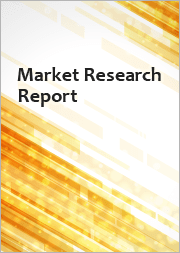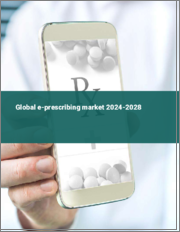
|
시장보고서
상품코드
1593494
전자처방전 시장 규모, 점유율 및 성장 분석(제품/서비스별, 제공방식별, 물질별, 용도별, 최종사용자별, 지역별) : 산업 예측(2024-2031)E-Prescribing Market Size, Share, Growth Analysis, By Product & Service (Solutions, Services), By Delivery Mode (Web- & Cloud-Based Solutions, On-Premises Solutions), By Substances, By Usage, By End User, By Region - Industry Forecast 2024-2031 |
||||||
세계 전자처방전 시장 규모는 2022년 21억 달러로 평가되었습니다. 2023년 25억 9,000만 달러에서 2031년에는 139억 3,000만 달러로 확대될 것으로 예상되며, 예측 기간(2024 - 2031) 동안 23.40%의 연평균 복합 성장률(CAGR)을 나타낼 전망입니다.
세계 전자처방전 시장은 EPSC(규제 의약품 전자처방전)의 도입이 확대되고 정부 정책의 호의적인 정책으로 인해 큰 성장세를 보이고 있습니다. 또한, 환자 안전에 대한 인식이 높아지면서 시장 확대에 박차를 가하고 있으며, 코로나19 팬데믹으로 인해 의료 기관이 감염 위험을 최소화하고 처방약에 쉽게 접근할 수 있는 이점을 강조하면서 전자처방전 도입이 가속화되고 있습니다. 전자처방전은 의료진이 처방전을 약국에 직접 보낼 수 있게 해주고, 처방전 프로세스를 디지털화하여 정확성을 높이고, 실수를 줄이며, 효율성을 높일 수 있습니다. 또한 다양한 의료 시스템과의 원활한 통합을 실현하여 의약품에 대한 적시 접근을 용이하게하고 환자 치료를 향상시킬 수 있습니다. 이러한 요소들이 결합되어 전 세계적으로 전자 처방전 솔루션에 대한 수요가 증가하고 있습니다.
목차
서론
- 분석 목적
- 정의
- 시장 범위
분석 방법
- 정보 조달
- 2차 데이터 소스와 1차 데이터 소스
- 시장 규모 예측
- 시장 상정과 제한
주요 요약
- 시장 개요와 전망
- 수급 동향 분석
- 부문별 기회 분석
시장 역학과 전망
- 시장 역학
- 성장 촉진요인
- 기회
- 성장 억제요인
- 과제
- Porter의 Five Forces 분석
주요 시장 인사이트
- 주요 성공 요인
- 경쟁 정도
- 주요 투자 기회
- 시장 생태계
- 규제 상황
- 사례 연구 분석
- 기술 분석
전자 처방전 시장 : 제품 및 서비스별
- 시장 개요
- 솔루션
- 통합형 솔루션
- 스탠드얼론 솔루션
- 서비스
- 지원 및 정비 서비스
- 구현 서비스
- 네트워크 서비스
- 트레이닝 및 교육 서비스
전자 처방전 시장 : 제공 방식별
- 시장 개요
- Web/클라우드 기반 솔루션
- 온프레미스 솔루션
전자 처방전 시장 : 물질별
- 시장 개요
- 규제 물질
- 규제 대상 외 물질
전자 처방전 시장 : 용도별
- 시장 개요
- 핸드헬드 디바이스
- 컴퓨터 기반 디바이스
전자 처방전 시장 : 최종사용자별
- 시장 개요
- 병원
- 진료소 근무의
- 약국
전자 처방전 시장 : 지역별
- 시장 개요
- 북미
- 미국
- 캐나다
- 유럽
- 독일
- 스페인
- 프랑스
- 영국
- 이탈리아
- 기타 유럽
- 아시아태평양
- 중국
- 인도
- 일본
- 한국
- 기타 아시아태평양
- 라틴아메리카
- 브라질
- 기타 라틴아메리카
- 중동 및 아프리카(MEA)
- 걸프협력회의(GCC) 국가
- 남아프리카공화국
- 기타 중동 및 아프리카
경쟁 구도
- 주요 5개사 비교
- 주요 기업의 시장 포지셔닝(2023년)
- 주요 시장 기업이 채택한 전략
- 시장에서의 최근 활동
- 주요 기업의 시장 점유율(2023년)
주요 기업 개요
- Epic Systems Corporation(미국)
- Surescripts-Rxhub, LLC(미국)
- Henry Schein, Inc.(미국)
- DRFIRST, Inc.(미국)
- DrChrono(미국)
- MDToolbox(미국)
- eClinicalWorks(미국)
- Renaissance Health(미국)
- Moderna Therapeutics(미국)
- MediMobile(미국)
- ePrescribeRx(미국)
- HealthWave(미국)
- RxNT(미국)
- DrChrono(미국)
- MediLedger Network(미국)
- Sunknowledge Services Inc.(미국)
- PointClickCare(캐나다)
- RxVantage(미국)
Global E-Prescribing Market size was valued at USD 2.1 billion in 2022 and is poised to grow from USD 2.59 billion in 2023 to USD 13.93 billion by 2031, growing at a CAGR of 23.40% during the forecast period (2024-2031).
The global e-prescribing market is experiencing significant growth, driven by the rising adoption of electronic prescribing for controlled substances (EPSC) and favorable government policies. Additionally, growing awareness of patient safety is further fueling market expansion. The COVID-19 pandemic accelerated the adoption of e-prescribing as healthcare facilities sought ways to minimize infection risks, highlighting the benefits of easier access to prescription medications. E-prescribing, which enables medical professionals to send prescriptions directly to pharmacies, improves accuracy, reduces errors, and enhances efficiency by digitizing the prescription process. It also ensures seamless integration with various medical systems, facilitating timely medication access and improving patient care. These factors collectively contribute to the growing demand for e-prescribing solutions worldwide.
Top-down and bottom-up approaches were used to estimate and validate the size of the Global E-Prescribing market and to estimate the size of various other dependent submarkets. The research methodology used to estimate the market size includes the following details: The key players in the market were identified through secondary research, and their market shares in the respective regions were determined through primary and secondary research. This entire procedure includes the study of the annual and financial reports of the top market players and extensive interviews for key insights from industry leaders such as CEOs, VPs, directors, and marketing executives. All percentage shares split, and breakdowns were determined using secondary sources and verified through Primary sources. All possible parameters that affect the markets covered in this research study have been accounted for, viewed in extensive detail, verified through primary research, and analyzed to get the final quantitative and qualitative data.
Global E-Prescribing Market Segmental Analysis
Global E-Prescribing Market is segmented by Product & Service, Delivery Mode, Substances, Usage, End User, and Region. Based on Product & Service, the market is segmented into Solutions, and Services. Based on Delivery Mode, the market is segmented into Web- & Cloud-Based Solutions, and On-Premises Solutions. Based on Substances, the market is segmented into Controlled Substances, and Non-Controlled Substances. Based on Usage, the market is segmented into Handheld Devices, and Computer-Based Devices. Based on End User, the market is segmented into Hospitals, Office-Based Physicians, and Pharmacies. Based on region, the market is segmented into North America, Europe, Asia Pacific, Latin America and Middle East & and Africa.
Driver of the Global E-Prescribing Market
The growing government support for the adoption of Electronic Health Record (EHR) solutions, combined with the rising need to manage escalating healthcare costs, is a key driver for the global E-Prescribing market. The integration of EHR systems has significantly improved prescription management by enhancing the accessibility of patient medical histories, offering more comprehensive data than standalone e-prescribing systems. This seamless flow of information has streamlined the prescription process, boosting efficiency and reducing errors. As a result, there is an increasing demand for e-prescribing solutions that can leverage EHR systems to improve patient care and optimize healthcare workflows, further driving market growth.
Restraints in the Global E-Prescribing Market
One of the primary restraints hindering the growth of the global E-Prescribing market is the high cost associated with the implementation and maintenance of e-prescribing systems integrated with Electronic Health Records (EHR). The expense involved in adopting such solutions poses a significant challenge, particularly in developing economies where budget constraints and limited healthcare IT infrastructure further impede adoption. These regions struggle to implement advanced technological solutions due to the financial burden and lack of adequate support, preventing the widespread adoption of e-prescribing systems. As a result, the growth of the market is slowed, especially in emerging economies that face these infrastructural and economic challenges.
Market Trends of the Global E-Prescribing Market
One of the key trends driving the growth of the global e-prescribing market is the increasing opioid crisis in the United States. The e-prescribing of controlled substances (EPCS) system provides a secure and transparent solution, reducing the potential for misuse and fraud. By implementing electronic prescriptions for controlled medications, healthcare providers can more easily and safely prescribe necessary drugs to patients who genuinely need them, while simultaneously mitigating the risks associated with prescription drug abuse. This shift towards digital prescriptions is seen as an effective strategy to combat the opioid epidemic, promoting both patient safety and regulatory compliance, thus accelerating the adoption of e-prescribing technologies across the healthcare sector.
Table of Contents
Introduction
- Objectives of the Study
- Definitions
- Market Scope
Research Methodology
- Information Procurement
- Secondary & Primary Data Sources
- Market Size Estimation
- Market Assumptions & Limitations
Executive Summary
- Market Overview Outlook
- Supply Demand Trend Analysis
- Segmental Opportunity Analysis
Market Dynamics & Outlook
- Market Dynamics
- Drivers
- Opportunities
- Restraints
- Challenges
- Porters Analysis
- Competitive rivalry
- Threat of Substitute Products
- Bargaining Power of Buyers
- Threat of New Entrants
- Bargaining Power of Suppliers
Key Market Insights
- Key Success Factor
- Degree of Competition
- Top Investment Pockets
- Ecosystem of the Market
- Regulatory Landscape
- Case Study Analysis
- Technology Analysis
E-Prescribing Market by Product & Service
- Market Overview
- Solutions
- Integrated Solutions
- Standalone Solutions
- Services
- Support & Maintenance Services
- Implementation Services
- Network Services
- Training & Education Services
E-Prescribing Market by Delivery Mode
- Market Overview
- Web- & Cloud-Based Solutions
- On-Premises Solutions
E-Prescribing Market by Substances
- Market Overview
- Controlled Substances
- Non-Controlled Substances
E-Prescribing Market by Usage
- Market Overview
- Handheld Devices
- Computer-Based Devices
E-Prescribing Market by End User
- Market Overview
- Hospitals
- Office-Based Physicians
- Pharmacies
E-Prescribing Market Size by Region
- Market Overview
- North America
- USA
- Canada
- Europe
- Germany
- Spain
- France
- UK
- Italy
- Rest of Europe
- Asia Pacific
- China
- India
- Japan
- South Korea
- Rest of Asia-Pacific
- Latin America
- Brazil
- Rest of Latin America
- Middle East & Africa (MEA)
- GCC Countries
- South Africa
- Rest of MEA
Competitive Landscape
- Top 5 Player Comparison
- Market Positioning of Key Players, 2023
- Strategies Adopted by Key Market Players
- Recent Activities in the Market
- Key Companies Market Share (%), 2023
Key Company Profiles
- Epic Systems Corporation (US)
- Company Overview
- Business Segment Overview
- Financial Updates
- Key Developments
- Surescripts-Rxhub, LLC (US)
- Company Overview
- Business Segment Overview
- Financial Updates
- Key Developments
- Henry Schein, Inc. (US)
- Company Overview
- Business Segment Overview
- Financial Updates
- Key Developments
- DRFIRST, Inc. (US)
- Company Overview
- Business Segment Overview
- Financial Updates
- Key Developments
- DrChrono (US)
- Company Overview
- Business Segment Overview
- Financial Updates
- Key Developments
- MDToolbox (US)
- Company Overview
- Business Segment Overview
- Financial Updates
- Key Developments
- eClinicalWorks (US)
- Company Overview
- Business Segment Overview
- Financial Updates
- Key Developments
- Renaissance Health (US)
- Company Overview
- Business Segment Overview
- Financial Updates
- Key Developments
- Moderna Therapeutics (US)
- Company Overview
- Business Segment Overview
- Financial Updates
- Key Developments
- MediMobile (US)
- Company Overview
- Business Segment Overview
- Financial Updates
- Key Developments
- ePrescribeRx (US)
- Company Overview
- Business Segment Overview
- Financial Updates
- Key Developments
- HealthWave (US)
- Company Overview
- Business Segment Overview
- Financial Updates
- Key Developments
- RxNT (US)
- Company Overview
- Business Segment Overview
- Financial Updates
- Key Developments
- DrChrono (US)
- Company Overview
- Business Segment Overview
- Financial Updates
- Key Developments
- MediLedger Network (US)
- Company Overview
- Business Segment Overview
- Financial Updates
- Key Developments
- Sunknowledge Services Inc. (US)
- Company Overview
- Business Segment Overview
- Financial Updates
- Key Developments
- PointClickCare (Canada)
- Company Overview
- Business Segment Overview
- Financial Updates
- Key Developments
- RxVantage (US)
- Company Overview
- Business Segment Overview
- Financial Updates
- Key Developments



















